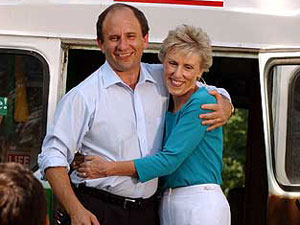From his decision to host Chinese president Xi Jinping at his home in Mar-a-Lago Florida to his apparent refusal to shake Angela Merkel’s hand during her recent visit to the White House, President Trump has been forging his own path when it comes to US foreign relations, bucking tradition and instead providing his own personal brand of public diplomacy. The same says-what-he-thinks, does-what-he-likes mannerisms that propelled him to victory in the 2016 elections are now being used in the White House to greet foreign dignitaries and leaders alike.
While such unpredictability may have connected with American voters, President Trump may not always have the luxury of an American audience. As he gets further into his administration, the time may come when President Trump is expected to deliver a set of remarks in front of a foreign audience. Whether he gives just three speeches abroad, like President Bush, or a dozen, like President Obama, there are a few lessons that President Trump can learn from previous administrations experiences abroad. Here are the four things President Trump should remember for his first speech abroad.
1. Choose a good location
First things first — choose an appropriate location for your speech. Visuals matter. Ronald Reagan’s speech in West Berlin, for example, was amplified by the choice of his location. His challenge to Secretary Gorbachev to “tear down this wall” was made more powerful because the chosen location for the speech.

He allowed audiences viewing the speech live, as well as those watching from around the world, to see the very wall to which he was referring; to view the physical boundary that separated the East and West. By remembering that speeches are not only heard, but also watched, a speech can become more powerful and more poignant.
2. Speech should be connected to policy
In Matthew Wallins’ blog post for the American Security Project (ASP), he states that matching action to words is a critical factor in maintaining the credibility for public diplomacy officials. When the president goes abroad, he is, in effect, acting as the US’s most powerful public diplomacy official; thus, his words must be connected to US policy action in order to maintain credibility.
During his historic trip to China, President Richard Nixon’s primary policy goal was to normalize relations and communications between the two nations.

The toast, which he gave at a banquet in Peking, emphasized Nixon’s desire to exist in peace with China, while more subliminally promising to the Chinese people that the US would not try to influence their system of government.
Chairman Mao reportedly appreciated his honesty, and as a result, state media reported on their meeting favorably.
3. Don’t be afraid to take on the real issues.
Speeches provide a unique opportunity for presidents to address a captive international audience, as well as communities that they may not otherwise have access to. Though it may be uncomfortable at times, the best way to capitalize on the audience’s’ attention is to be forthright about the issues you want them to pay attention to. Wallin also makes this point in his ASP blog; transparency is key.
For example, when President Obama gave one of his first international speeches at a university in Cairo, he did not attempt to shift away from the significant policy issues that divided the Muslim world and the US. While the purpose of President Obama’s strategy in the speech was to open a new dialogue with Muslim communities, he went about this effort in two ways: the first method was to admit and apologize for what he perceived to be the previous administration’s mistakes; the second, was using his platform to address the contentious issues between the US and the Muslim communities. He openly condemned attempts by Muslim leaders to deny the Holocaust and 9/11. He rejected the use of violence by Palestinians.

By seizing upon his position and his audience to address the actual issues facing the two sides, President Obama was able to turn the page on one chapter of Islamic/ American relations, and have the new beginning he sought.
4. But make sure your message doesn’t fall on deaf ears.
Like any public diplomacy officer, presidents must first understand the cultural context of the country they are walking into, before they can expect to be listened to by the general public. At the end of the day, if no one in the audience is listening, the speech will have no impact. It is therefore important that President Trump connects with his audience, and shows some understanding and appreciation for the history and culture he’s addressing.
Each speech requires a different method of connection. In his Cairo speech, for example, President Obama used personal testimony to engage with the Muslim audience he was attempting to reach by describing the deep ties to Islam that his Kenyan family has, as well as his own experiences living in Indonesia as a young boy. In the first President Bush’s address to the people of Leiden, he connected the history of the early Pilgrim settlers to the proud history of the Dutch people. President Kennedy, meanwhile, in his famous “Ich bin ein Berliner” speech, used the German language to demonstrate his efforts to understand the position of the people of Berlin and of Germany more broadly. Even these small acts can have profound effects on the reception of the speech.
Caveat: The views expressed in this blog are the author’s own and do not necessarily reflect those of the Institute for Public Diplomacy and Global Communication or the George Washington University.









